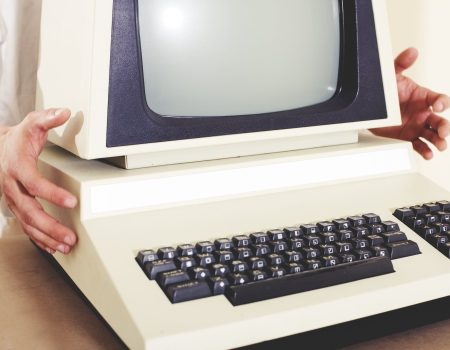The Power Of Vector Logos
Understandably, not everyone knows what a vector logo is and why it is important to know what logo files you need when teaming up with a professional logo designer.
In this blog, I would like to explain what vector file logos are and why they are superior to raster images. Most importantly, I will explain exactly what files formats you will get from me once you have finalized a logo design project. This will make it easier for you to understand what you actually ordered.
Let’s start at the beginning
Originally, vector files have their origins in computer graphics. In the early days of computers, graphics were represented by pixels. Basically, small squares of color arranged in a grid. While these graphics were easy to create and display, they had one significant drawback: they couldn’t be scaled without losing resolution.

However, vector graphics solved this problem by representing graphics as mathematical equations. Rather than pixels. For instance, this allowed graphics to be scaled infinitely without losing resolution. More so making them ideal for applications like logos and illustrations.
Interestingly, the first vector graphics software was created in the 1960s, but it wasn’t until the development of personal computers in the 1980s that vector graphics became widely used. Today, vector files are used in a wide range of applications. Everything from graphic design to manufacturing to computer animation.
Understandably, vector logos are powerful tools that offer many benefits over traditional bitmap images.
Let’s go more into details:
Understanding Vector File Logos
First of all, like we stated previously, vector file logos are digital images that are created using mathematical equations rather than pixels. So, this means that they can be resized without losing image quality or becoming pixelated.
They are commonly used in professional design projects such as in branding, print design, and web development. Making them ideal for use across different mediums, from business cards to billboards. Above all, this unique characteristic provides several advantages that make vector logos a preferred choice for businesses,
Vector Logos Can Easily Be Edited
Secondly, the main advantage of vector file logos is that they can be easily edited and manipulated. So, designers can easily tweak colors, resize or reshape the logo to best suit the design requirements. Even without compromising the quality of the image. Furthermore, this flexibility can help brands stay current with changing market trends or simply refresh their look over time.
Thirdly, vector file logos are commonly saved in formats such as .ai, .eps and .svg and can only be opened and edited in programs such as Adobe Illustrator and CorelDRAW. However, they can be exported into various file formats such as JPG, PNG or PDF for different use cases.
Therefore, having a vector file of your logo is important as it can ensure that your logo looks sharp and clean across all mediums and sizes. However, it is important to work with a designer who understands the importance of vector logos for professional branding. After all, vector logos are an essential part of modern branding and marketing strategies. More so, offering impressive visual impact and practical versatility.
Exploring Vector Logos Format
More importantly, we now know that vector logo formats are digital image files that use mathematical calculations. Most of all, to ensure graphics remain smooth and that they can be scaled up or down without losing quality. Therefore, common vector formats include AI (Adobe Illustrator), EPS (Encapsulated PostScript), and SVG (Scalable Vector Graphics).
Another crucial fact is that AI is a proprietary format used in Adobe Illustrator and can only be opened in the software. However, EPS is compatible with multiple design software but is not ideal for web use. Whereas SVG is a web-friendly format that can be easily edited and scaled using a text editor.
Most of all, vector logos are essential for printing purposes as they guarantee the graphics will look crisp and clear no matter the size or resolution of the print. For instance, it’s important to use the correct format for the intended purpose and to ensure the logo remains true to its original design.
Vector Logo : A Game-Changer In Design
Understandably, vector logos are superior to raster images because they can be scaled up without losing clarity due to being mathematically defined lines and shapes.
For example, vector logos are also easily edited and manipulated for experimentation with different styles and printing colors without losing quality. Therefore, this enables businesses to maintain a consistent brand image. Even on all marketing materials, from business cards to billboards.
Overall, vector logos revolutionize design, making it easier for designers to craft impactful branding elements for clients.
Optimizing Logos With Vector Format
So, to optimize a logo with a vector format, start by creating the logo in a vector-based design software. Like for example in Adobe Illustrator or CorelDRAW. This will ensure that the logo is scalable to any size. Next, select appropriate colors and fonts to make the logo visually appealing and memorable. Be mindful of the overall design, ensuring that it is simple yet professional looking.
Once the logo is finalized, save it in vector format as an EPS or PDF file. More importantly, this will allow for easy editing and resizing in the future. By using a vector format for logos, businesses can ensure that their brand identity remains consistent across all marketing materials and platforms.
Vector Files Vs Raster Files

Interestingly, the opposite of vector files would be raster images. Furthermore, these images are made up of tiny pixels arranged in a grid. Raster images are resolution dependent, which means their quality can be diminished if they are resized or stretched beyond their original dimensions.
For instance, raster images are commonly used for photographs and other images that have fine, continuous details. For example, such as textures, gradients, and shading. They are also ideal for digital paintings and illustrations that require a more natural, organic look. On the other hand, vector files are better suited for artwork that requires clean lines, and shapes, such as logos, icons, and illustrations that need to be scaled up or down without losing quality. See more about the biggest file format difference
Unleashing The Potential Of Vector Logos
Unleashing the potential of vector logos involves recognizing and leveraging their unique qualities to enhance a brand’s visual identity and overall impact.
Above all, they are balanced logos that you can adapt any color and size to, which is crucial when you are testing your brand out. Another potential is that vector logos make it easy to maintain a cohesive brand image across different platforms and media. Just add, remove, add again and keep trying your brand on social media until you get it right.
Printing becomes easy as vector logos can be printed across a wide range of marketing materials, from business cards and brochures to banners and merchandise. Furthermore, the logo will edgy and memorable, reinforcing the brand’s visual impact.
What Files Should You Get From A Logo Designer
When your logo project is complete if you work with us at The Logo Company then you will receive the following file types:
- EPS file* – An important master file. Of course, editable in Adobe Illustrator and it is a vector file which means it can be re-sized without loss of quality. Making this is the file type that will be requested by most professionals. So if you don’t know which file to give, then use this one.
Furthermore, the EPS file in your pack is the master file, editable in Adobe Illustrator. We design in Illustrator not Photoshop which is why the PSD is not layered.
Adobe Illustrator A Vector Drawing Tool
Most of all, Adobe Illustrator is the industry standard vector drawing tool. Vector files do not suffer from loss of quality when re-sized because the image software uses a technique called vectoring to create the image. After all, this is very important for logo design as the logo will need to look good in all sizes.
- PSD file* – So, this is just an export from the EPS file and is not editable. For example, this file can be opened in Adobe Photoshop and has a transparent background.
- PNG file* – More importantly, this file also has a transparent background but does not require any specialist software to open it.
- TIF file* – A CMYK color for lithographic printing. Most people don’t know but this file may look a different color to the other file types but don’t worry. Well, this is just because your monitor cannot properly display CMYK color.
- JPG files* – You will receive 4 different JPG files. JPG files can be opened on any computer and are for home/office use. Furthermore, you can import these files into Microsoft applications like Word and PowerPoint. Also, you will receive 3 different size JPG files as they do not re-size well. Lastly, you also receive a greyscale JPG file, this is for Trademark registration.
- TXT file* – Not to forget the TXT file which is a short document containing the font and color information for your new logo.
DST Files For Embroidery Machines
Sometimes customers come to me and ask for a DST file. However, DST files can only be made on embroidery machines. Therefore, you can send the EPS file from your package and your embroider will be able to create a DST from that.
Last Few Words
In conclusion, vector logos are essential for businesses as they provide a professional and consistent brand image across all marketing channels. Like we have explained they are versatile. Easily used on any medium or platform, and are editable without losing quality. However, it is important to note that although the vector logos are suitable for websites, print and digital media, they may not be suitable for complex illustrations or photographs. In such cases, raster image files should be used.
Overall, a vector logo is an essential element of any company branding strategy, and ensures the brand remains consistent, recognizable and professional.
